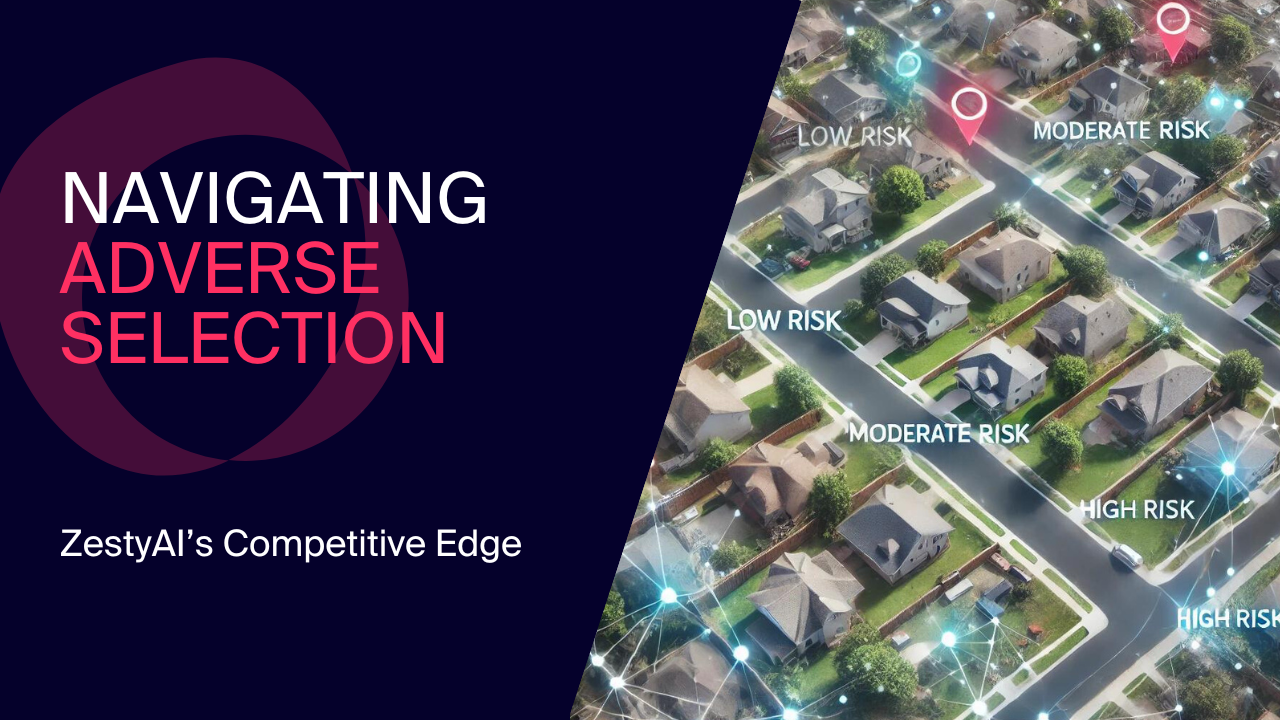Climate Intelligence: How AI Shifts Risk and Redefines the Insurance Landscape
In today’s competitive insurance market, carriers equipped with AI-powered property insights gain a significant edge, enabling them to assess and manage risk with unprecedented accuracy.
By leveraging advanced technologies like artificial intelligence and computer vision, insurers can now analyze property-specific risks with a level of detail that was previously unattainable.
Z-FIRE: Leading the Way in Wildfire Risk Assessment
For example, Z-FIRE, ZestyAI’s leading AI-powered wildfire risk solution, has been widely adopted by carriers across the western U.S., providing them with critical insights to underwrite new business in wildfire-prone areas.
This information advantage drives a phenomenon known as adverse selection, where disparities in risk assessment capabilities lead to an uneven distribution of risk across the market. Insurers without access to advanced tools like Z-FIRE are at a distinct disadvantage, as they continue to underwrite policies based on outdated methods.
Insurers without access to advanced tools like Z-FIRE are at a distinct disadvantage, as they continue to underwrite policies based on outdated methods.
Over time, this imbalance results in a higher concentration of risk among carriers relying on traditional approaches, leading to significant discrepancies in loss ratios between competitors.

Transforming Underwriting Practices
Property-Specific Risk Analytics
Z-FIRE exemplifies how property-specific risk analytics can transform underwriting practices, particularly in high-risk areas. By providing detailed insights into the frequency and severity of potential wildfire losses, Z-FIRE allows carriers to identify and avoid high-risk policies more effectively.
However, even after these properties are identified and potentially avoided by Z-FIRE users, they remain in the market. This leaves insurers without such insights increasingly vulnerable to the costly effects of adverse selection.
Z-FIRE and Regulatory Milestones
Adapting to Regulatory Requirements
Z-FIRE was the first AI model for wildfire risk assessment to obtain approval as part of a carrier rate filing from the California Department of Insurance (CDI). This milestone highlights ZestyAI’s leadership in adapting to the evolving regulatory landscape, where transparency and risk mitigation are becoming increasingly critical.
New regulations in states like California and Oregon now require insurers to incentivize homeowners’ risk reduction efforts and provide clear, detailed information about rate adjustments and policy decisions. This push for greater transparency aligns with the capabilities of advanced tools like Z-FIRE, which offer insurers the detailed, property-specific data needed to comply with these regulations and ensure fair treatment of policyholders.
Adverse Selection in a Changing Market
Risk Concentration and Legacy Approaches
As ZestyAI’s insurance partners continue to vet properties using state-of-the-art risk models, the proportion of very high-risk policies in the remaining market continues to grow.
This shift underscores the unsustainability of legacy approaches to wildfire risk, as the environment changes and competitors armed with superior insights make new policies even riskier for those lagging behind. Insurers relying on outdated risk models may not realize how the market has shifted until the claims process reveals significant and unforeseen losses.
Insurers relying on outdated risk models may not realize how the market has shifted until the claims process reveals significant and unforeseen losses.

Z-FIRE's Growing Value in the Insurance Industry
With a growing percentage of insurers adopting Z-FIRE, its value as a tool for underwriting new business becomes more evident than ever. While the threat of adverse selection looms large for carriers not using AI-powered insights, those with access to these advanced tools are better positioned to navigate the evolving landscape.
Preparing for Future Challenges
As wildfire seasons become increasingly severe and the regulatory environment continues to tighten, the ability to accurately assess and transparently communicate risk is crucial to the stability of the insurance market.
The ability to accurately assess and transparently communicate risk is crucial to the stability of the insurance market.
Ultimately, insurers who embrace AI-powered property insights gain a competitive edge, allowing them to minimize losses, stay ahead of regulatory demands, and outpace competitors still relying on traditional methods. In a market where information is power, ZestyAI’s platform provides the advantage needed to thrive.
Adverse Selection's Implications for Pricing
The Role of Property Mitigation in Risk Assessment
Adverse selection has significant implications for pricing. Consider the Park Fire perimeter, an area with a markedly elevated wildfire risk. Property mitigation plays a crucial role in risk assessment. The majority of properties in this area carry a high level of risk; 54% are categorized as “very high” risk according to the Z-FIRE L2 score.
Identifying Lower-Risk Properties
However, there are still opportunities to identify lower-risk properties, even within wildfire-prone regions. In fact, low and moderate-risk properties account for 17% of those within the Park Fire perimeter, presenting valuable opportunities for insurers to differentiate pricing and capture lower-risk business even in high-risk areas.

How Does Adverse Selection Impact Pricing?
Territory-Based Pricing vs. Property-Specific Scores
So how does this impact pricing? Let’s break it down with an example. Assuming a carrier’s statewide average wildfire premium is $280, we can assume the average wildfire premium is $843 for this area based on ZestyAI’s Z-FIRE model output. Applying territory-based pricing would mean that every home pays roughly the same wildfire premium per dollar of coverage.
The Benefit of Z-FIRE’s Tailored Approach
However, by leveraging Z-FIRE’s property-specific scores, insurers can adopt a more tailored approach that accurately reflects each property’s unique risk profile.
By leveraging Z-FIRE’s property-specific scores, insurers can adopt a more tailored approach that accurately reflects each property’s unique risk profile.
For example, a low-risk property would be charged a wildfire premium of $513, while a very high-risk property could be assigned a load of $986. This strategy not only helps attract lower-risk customers through preferred pricing, but also ensures that higher-risk properties are adequately rated.
Outpacing Competitors Through Risk-Based Pricing
In contrast, carriers whose pricing strategies are based on the average premium will be most competitive for high-risk properties but will struggle to attract lower-risk ones. Z-FIRE allows carriers to outpace risk and competitors alike.

